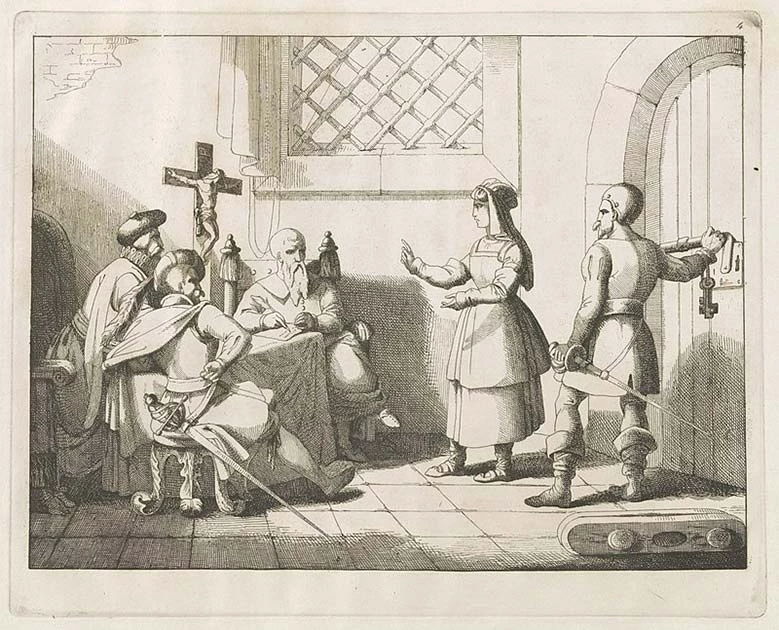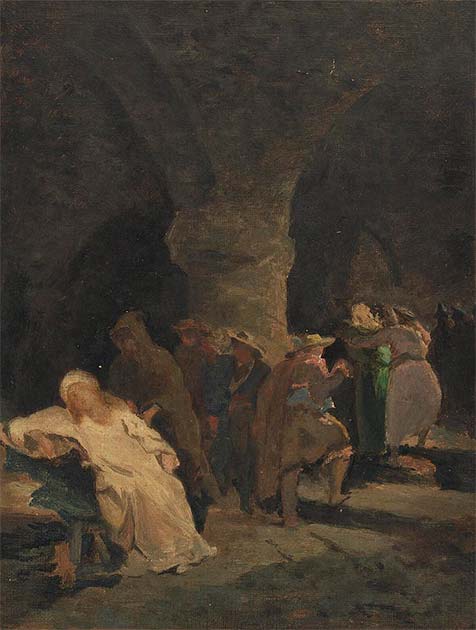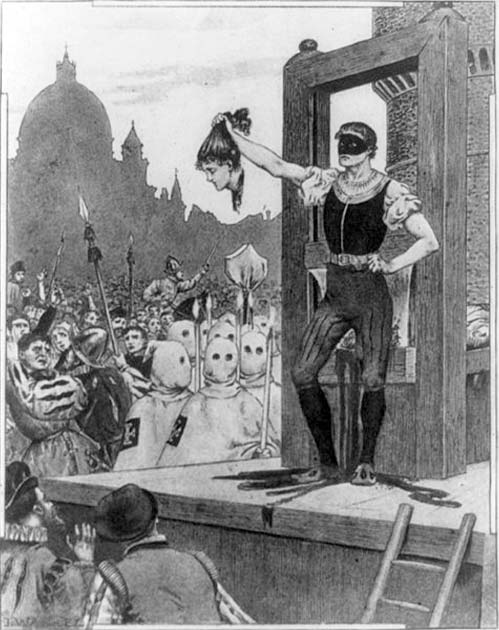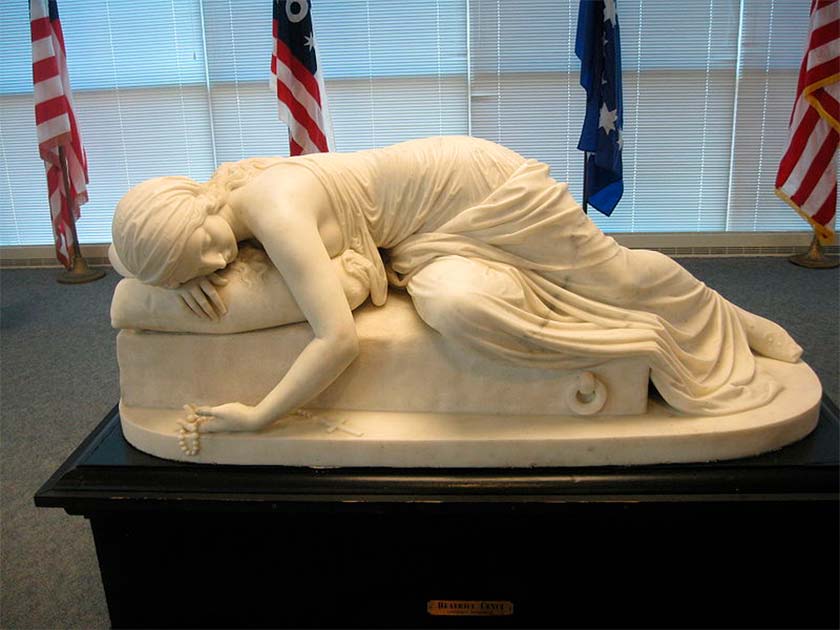“There is a fixed and pale composure upon the features; she seems sad and stricken down in spirit, yet the despair thus expressed is lightened by the patience of gentleness… The lips have that permanent meaning of imagination and sensibility which her suffering has not repressed… Her eyes, which we are told were remarkable for their vivacity, are swollen with weeping and lustreless, but beautifully tender and serene. In the whole mien there is a simplicity and dignity which, united with her exquisite loveliness and deep sorrow, are inexpressibly pathetic.”
These are the words Percy Shelley wrote to describe the tragic Roman noblewoman Beatrice Cenci. Who was this sorrowful yet beautiful woman, and what did she do to inspire such a powerful description?
Beatrice Cenci
Beatrice Cenci was a Roman noblewoman born on February 6, 1577, to her mother, Ersilia Santacroce, and father, Count Francesco Cenci. Count Francesco Cenci was described as “a man of great wealth but dissolute habits and violent temper”.
He was incredibly cruel and was said to have physically abused Ersilia and her sons. Even worse, he repeatedly raped Beatrice Cenci during her childhood. The dastardly count’s bad behavior was no secret, he was often placed in jail and made to pay fines for his sex crimes against others, but because he was a member of the nobility, he was always released from prison early.
Poor Beatrice Cenci made many attempts to alert authorities about the abuse from her father, but nobody seemed to care. The public knew the count was violent, but it was seen as “the Cenci family’s problems.”

When Beatrice Cenci was seven years old, her mother passed away. Shortly after their mother died, Beatrice and her sister Antonina were sent by their father to live in a small monastery in the Rione Colonna of Rome.
Eventually, Count Francesco Cenci remarried a woman named Lucrezia Petroni. The Cenci daughters were allowed to return home. Still, once Count Ceni found out that Beatrice Cenci had reported his abuse to the authorities, he banished her and his new wife to live in the family’s second castle in the Abruzzi mountains in the northeast of Rome.
The Murder Plot
Lucrezia Petroni and Beatrice concocted a plot to kill Count Francesco Cenci as payback for the abuse and violence. The two women were not the only ones who were in on this plot.
- The Tavora Executions: An Entire Noble Family Put to the Sword
- Sophonisba: Defiant Queen of the Punic Wars
Beatrice’s elder brother Giacomo and her stepbrother from her father’s second marriage Bernardo were involved. The plan was this, the next time Count Cenci came to visit the castle, the group would strike with the help of some drugged wine to put him to sleep.
At some point in their scheming, two vassals (liege subjects), one of which was said to have been the secret lover of Beatrice Cenci, agreed to help kill Count Francesco Cenci. The two vassals supplied Beatrice’s father with drugged wine before letting the four Cenci family members have at the imcapacitated man.
The Cencis all bludgeoned Francesco to death with a hammer before casually tossing his body off of a balcony in some sort of attempt to make the death appear as an accident. While the authorities in Rome often ignored the disturbing behavior of Francesco Cenci, the papal authorities did not believe that the count fell off the balcony to his death. An investigation was opened into the suspected murder of the nobleman.
Death Sentences
Beatrice Cenci’s lover was captured and tortured in an effort to gain information about what happened in the Cenci castle, but he never said a word. He was so devoted to Beatrice that even though he was forced to endure brutal torture, he died without speaking about what his love and her family did.
A family friend of the Cenci’s learned what happened to Beatrice Cenci’s lover and ordered that the second vassal who was present at the murder to be killed. It was a “six people can keep a secret if two of them are dead and not blood relatives” kind of move.
The plot was eventually discovered, and the papal authorities arrested Giacomo, Bernardo, Lucrezia, and Beatrice Cenci. The group was all found guilty of murder and sentenced to death.
However, when the Roman public heard about the death sentences given to the Cenci family, they were upset. The public was well aware of the reasons why the family was pushed to commit murder.

Abuse and rape were atrocious, and the common people protested the papacy’s decision. This protest was semi-successful, and the uproar caused a short stay of execution. The pope at the time, Pope Clement VIII, ordered the execution be carried out because he feared triggering a “spate of familial murders”.
A local countess had been murdered by her own son for her fortune around the same time as the murder of Count Francesco Cenci. Pope Clement VIII planned to make an example of the Cenci family and that murder was a serious crime with serious repercussions.
- Joan of Arc: Divinely Inspired or Mentally Ill?
- The Witch-Queen of England? Revisiting Anne Boleyn’s Guilt
At daybreak, on September 11, 1599, the four Cencis were driven to the Sant’Angelo Bridge, where execution scaffolds were usually placed. While riding in the cart to the bridge, Giacomo Cenci was tortured by the executioners.
Once the part reached the bridge, Giacomo’s head was bashed in with a mallet before his corpse was then quartered before a live audience. Lucrezia and Beatrice Cenci were the next members of the family to be killed.
The two women were beheaded with a “small axe” rather than the standard large single blade. This was likely done in order to draw the execution out longer.

The final accused Cenci family member, Bernardo, was fortunately saved from public execution due to his age. He was only 12 years old at the time. Instead of being returned to his home, the executioners forced the boy to stand and watch the execution of his mother and step-siblings before he was promptly escorted to jail.
His properties were taken by the Pope, and it was announced that Bernardo was to be made a kitchen slave for the rest of his days. Luckily, Bernardo was released from jail and set free only a year after the executions.
Lady of Legend
Every year on the night before the anniversary of Beatrice Cenci’s execution, legend says that her ghost appears and walks along the Sant’Angelo Bridge carrying her severed head in her hands as she floats down the bridge. Beatrice Cenci became a symbol to the commoners of Rome of resistance to the aristocracy, and her death was seen as savage and unnecessary.
Did she deserve to be executed for trying to end her father’s pattern of physical and sexual abuse? No, she did not deserve to be killed for what she did.
However, committing murder, no matter the drive behind it, is illegal, and some punishments must occur when a crime is committed. The story of Beatrice Cenci has often been a source of inspiration to artists, playwrights, and authors for centuries. Some such works include:
- The Cenci: A Tragedy in Five Acts by Percy Shelley
- Nemesis by Alfred Nobel
- Beatrice Cenci (an opera) by both Berthold Goldschmidt and Antonin Artaud
- The Cenci an essay by Alexandre Dumas

There are many statues and paintings depicting and paying homage to Beatrice Cenci. Most notably, there are rumors that the painter Caravaggio who was present at the execution of the Cencis, might have used the event as the inspiration behind his famous decapitation painting Judith Beheading Holofernes.
There is a possible portrait of the beautiful Beatrice Cenci painted by the Baroque artist Guido Reni which is a recognizable portrait, even if people have never heard of Beatrice Cenci or her story. American sculptor Harriet Goodhue Hosmer created a stunning marble statue of Beatrice Cenci that is currently on display inside the Mercantile Library on the campus of the University of Missouri – St. Louis in St. Louis, Missouri.
Top Image: Beatrice Cenci in prison, awaiting her fate. Source: Achille Leonardi / Public Domain.